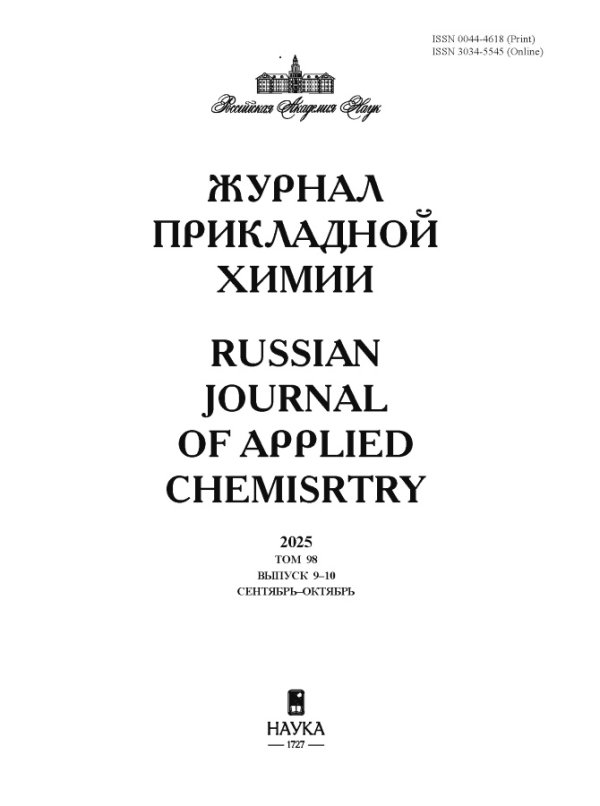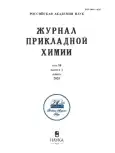Получение полимерного воска из вторичного полиэтилена в проточном реакторе
- Авторы: Красновских М.П.1, Мокрушин И.Г.1,2, Кетов А.А.3
-
Учреждения:
- Пермский государственный национальный исследовательский университет (ПГНИУ)
- Российский научный центр «Прикладная химия (ГИПХ)»
- Пермский национальный исследовательский политехнический университет (ПНИПУ)
- Выпуск: Том 98, № 1 (2025)
- Страницы: 80-88
- Раздел: Высокомолекулярные соединения и материалы на их основе
- URL: https://innoscience.ru/0044-4618/article/view/679813
- DOI: https://doi.org/10.31857/S0044461825010095
- EDN: https://elibrary.ru/LJAGJR
- ID: 679813
Цитировать
Полный текст
Аннотация
Работа посвящена проблеме утилизации отходов полиэтилена высокого давления и их переработке в синтетические воски методом пиролиза. Показано, что в ходе медленного пиролиза в реакторе проточного типа при 550°С, давлении 1.0 МПа при непрерывном удалении избыточных газообразных продуктов возможно получение воскообразных олигомеров. Методами термического анализа определены температуры плавления и размягчения по Вика, фиксируемого начала потери массы в условиях термогравиметрического анализа, установлены температуры каплепадения и определено содержание масла в синтезированных воскообразных продуктах. Методами протонного ядерного магнитного резонанса и хроматомасс-спектрометрии установлен состав продуктов пиролиза и показано, что образуется материал, сходный по составу с промышленными восками. Рассмотрена возможность модификации битума полученным воскообразным продуктом.
Об авторах
Марина Павловна Красновских
Пермский государственный национальный исследовательский университет (ПГНИУ)
Автор, ответственный за переписку.
Email: krasnovskih@yandex.ru
ORCID iD: 0000-0002-5187-5590
к.т.н., доцент
Россия, ПермьИван Геннадьевич Мокрушин
Пермский государственный национальный исследовательский университет (ПГНИУ); Российский научный центр «Прикладная химия (ГИПХ)»
Email: krasnovskih@yandex.ru
ORCID iD: 0000-0002-4095-8366
к.х.н., доцент
Россия, Пермь; Санкт-ПетербургАлександр Анатольевич Кетов
Пермский национальный исследовательский политехнический университет (ПНИПУ)
Email: krasnovskih@yandex.ru
ORCID iD: 0000-0002-5472-2194
д.т.н., проф.
Россия, ПермьСписок литературы
- Norouzi O., Haddadi S. A., Salaudeen S., Soltanian S., Bartocci P., Arjmand M. Dutta A. Catalytic upgrading of polyethylene plastic waste using GMOF catalyst: Morphology, pyrolysis, and product analysis // Fuel. 2024. V. 369. ID 31742. https://doi.org/10.1016/j.fuel.2024.131742
- Radhakrishnan K., Kumar P. S., Rangasamy G., Perumal L. P., Sanaulla S., Nilavendhan S., Manivasagan V., Saranya K. A critical review on pyrolysis method as sustainable conversion of waste plastics into fuels // Fuel. 2023. V. 337. ID 126890. https://doi.org/10.1016/j.fuel.2022.126890
- Ganesan A., Preetha H., Subathara S., Bhowmik S. Comparative analysis of carbon emission from products of virgin plastics and recycled plastics and their environmental benefits // Int. J. Environ. Sci. Technol. 2023. V. 20. N 6. P. 6713–6722. https://doi.org/10.1007/s13762-022-04337-y
- Loultcheva M. K., Proietto M., Jilov N., La Mantia F. P. Recycling of high density polyethylene containers // Polym. Degrad. Stab. 1997. V. 57. N 1. P. 77–81. https://doi.org/10.1016/s0141-3910(96)00230-3
- Papari S., Bamdad H., Berruti F. Pyrolytic conversion of plastic waste to value-added products and fuels: A review // Materials. 2021. V. 14. N 10. ID 2586. https://doi.org/10.3390/ma14102586
- Dirand M., Bouroukba M., Chevallier V., Petitjean D., Behar E., Ruffier-Meray V. Normal alkanes, multialkane synthetic model mixtures, and real petroleum waxes: Сrystallographic structures, thermodynamic properties, and crystallization // J. Chem. Eng. Data. 2002. V. 47. N 2. P. 115–143. https://doi.org/10.1021/je0100084
- Wang Y., Mao H., Lv Y., Chen G., Jiang Y. Comparative analysis of total wax content, chemical composition and crystal morphology of cuticular wax in Korla pear under different relative humidity of storage // Food Chem. 2021. V. 339. ID 128097. https://doi.org/10.1016/j.foodchem.2020.128097
- Doan C. D., To C. M., De Vrieze M., Lynen F., Danthine S., Brown A., Dewettinck K., Patel A. R. Chemical profiling of the major components in natural waxes to elucidate their role in liquid oil structuring // Food Chem. 2017. V. 214. P. 717–725. https://doi.org/10.1016/j.foodchem.2016.07.123
- Mülhaupt R. Catalytic polymerization and post polymerization catalysis fifty years after the discovery of Zieglerʹs catalysts // Macromol. Chem. Phys. 2003. V. 204. N 2. P. 289–327. https://doi.org/10.1016/10.1002/macp.200290085
- Bayat M. H., Abdouss M., Javanbakht M. Quantification of polyethylene wax in semibatch laboratory reactor and a study of different parameters on wax production as a by-product in the slurry ethylene polymerization // J. Appl. Polym. Sci. 2013. V. 127. N 2. P. 1027–1031. https://doi.org/10.1002/app.37916
- Mishra N., Patra N., Pandey S., Salerno M., Sharon M., Sharon M. Taguchi method optimization of wax production from pyrolysis of waste polypropylene: A green nanotechnology approach // J. Therm. Anal. Calorim. 2014. V. 117. P. 885–892. https://doi.org/10.1007/s10973-014-3793-4
- Kumar S., Panda A. K., Singh R. K. A review on tertiary recycling of high-density polyethylene to fuel // Resources, Conservation and Recycling. 2011. V. 55. N 11. P. 893–910. https://doi.org/10.1016/j.resconrec.2011.05.005
- Lange J. P. Managing plastic waste — sorting, recycling, disposal, and product redesign // ACS Sustain. Chem. Eng. 2021. V. 9. N 47. P. 15722–15738. https://doi.org/10.1021/acssuschemeng.1c05013
- Shanker R., Khan D., Hossain R., Islam M. T., Locock K., Ghose A., Sahajwalla V., Schand H., Dhodapkar R. Plastic waste recycling: Existing Indian scenario and future opportunities // Int. J. Environ. Sci. Technol. 2022. P. 1–18. https://doi.org/10.1007/s13762-022-04079-x
- Patil L., Varma A. K., Singh G., Mondal P. Thermocatalytic degradation of high density polyethylene into liquid product // J. Polym. Environ. 2018. V. 26. P. 1920–1929. https://doi.org/10.1007/s10924-017-1088-0
- DeNeve D., Joshi C., Samdani A., Higgins J., Seay J. Optimization of an appropriate technology based process for converting waste plastic in to liquid fuel via thermal decomposition // JSD. 2017. V. 10. N 2. P. 116–124. https://doi.org/10.5539/jsd.v10n2p116
- Jixing L. I. Study on the conversion technology of waste polyethylene plastic to polyethylene wax // Energy Sources. 2003. V. 25. N 1. P. 77–82. https://doi.org/10.1080/00908310290142136
- Li R., Shao N., Yue J., Liang B. Research on the influence of different warm-mix modifiers on pavement performance of bitumen and its mixture // Appl. Sci. 2023. V. 13. N 2. ID 955. https://doi.org/10.3390/app13020955
- Nizamuddin S., Boom Y. J., Giustozzi F. Sustainable polymers from recycled waste plastics and their virgin counterparts as bitumen modifiers: A comprehensive review // Polymers. 2021. V. 13. N 19. ID 3242. https://doi.org/10.3390/polym13193242
- Yi-qiu T., Lei Z., Wei-qiang G., Meng G. Investigation of the effects of wax additive on the properties of asphalt binder // Constr. Build. Mater. 2012. V. 36. P. 578–584. https://doi.org/10.1016/j.conbuildmat.2012.06.024
- Yero A. S., Hainin M. R. Influence of organic wax on bitumen characteristics // Am. J. Eng. Appl. Sci. 2011. V. 4. N 2. P. 265–269. https://doi.org/10.3844/ajeassp.2011.265.269
- Rubio M. C., Martínez G., Baena L., Moreno F. Warm mix asphalt: An overview // J. Cleaner Prod. 2012. V. 24. P. 76–84. https://doi.org/10.1016/j.jclepro.2011.11.053
- Caputo P., Abe A. A., Loise V., Porto M., Calandra P., Angelico R., Oliviero Rossi C. The role of additives in warm mix asphalt technology: An insight into their mechanisms of improving an emerging technology // Nanomaterials. 2020. V. 10. N 6. ID 1202. https://doi.org/10.3390/nano10061202
- Ferrotti G., Ragni D., Lu X., Canestrari F. Effect of warm mix asphalt chemical additives on the mechanical performance of asphalt binders // Mater. Struct. 2017. V. 50. P. 1–13. https://doi.org/10.1617/s11527-017-1096-5
- Ketov A., Korotaev V., Sliusar N., Bosnic V., Krasnovskikh M., Gorbunov A. Baseline data of low-density polyethylene continuous pyrolysis for liquid fuel manufacture // Recycling. 2022. V. 7. N 1. ID 2. https://doi.org/10.3390/recycling7010002
- Saito T., Nakaie S., Kinoshita M., Ihara T., Kinugasa S., Nomura A., Maeda T. Practical guide for accurate quantitative solution state NMR analysis // Metrologia. 2004. V. 41. N 3. ID 213. https://doi.org/10.1088/0026-1394/41/3/015
- Kulikova Y., Krasnovskikh M., Sliusar N., Orlov N., Babich O. Analysis and comparison of bio-oils obtained by hydrothermal liquefaction of organic waste // Sustainability. 2023. V. 15. N 2. ID 980. https://doi.org/10.3390/su15020980
- Ciesińska W., Liszyńska B., Zieliński J. Selected thermal properties of polyethylene waxes // J. Therm. Anal. Calorim. 2016. V. 125. P. 1439–1443. https://doi.org/10.1007/s10973-016-5706-1
- Umaru H. I., Yakubu M. K., Kolawole E. G., Baba M. Effect of pyrolysis temperature and time on wax production from waste polyethene // AJAS. 2014. V. 2. N 5. P. 644–649.
- Cheng L., Gu J., Wang Y., Zhang J., Yuan H., Chen Y. Polyethylene high-pressure pyrolysis: Better product distribution and process mechanism analysis // Chem. Eng. J. 2020. N. 385. ID 123866. https://doi.org/10.1016/j.cej.2019.123866
- Zhao D., Wang X., Mille J. B., Hube G. W. The chemistry and kinetics of polyethylene pyrolysis: A process to produce fuels and chemicals // ChemSusChem. 2020. N 13 (7). P. 1764–1774. https://doi.org/10.1002/cssc.201903434
- Arabiourrutia M., Elordi G., Lopez G., Borsella E., Bilbao J., Olazar M. Characterization of the waxes obtained by the pyrolysis of polyolefin plastics in a conical spouted bed reactor // J. Anal. Appl. Pyrol. 2012. V. 94. P. 230–237. https://doi.org/10.1016/j.jaap.2011.12.012
- Lal S., Anisia K. S., Kumar A. Depolymerization of HDPE to wax in the presence of a catalyst formed by homonuclear macrocyclic zirconium complex chemically bonded to alumina support // Appl. Catal. A. 2006. V. 303. N 1. P. 9–17. https://doi.org/10.1016/j.apcata.2006.01.016
- Al-Salem S. M., Dutta A. Wax recovery from the pyrolysis of virgin and waste plastics // Ind. Eng. Chem. Res. 2021. V. 60. N 22. P. 8301–8309. https://doi.org/10.1021/acs.iecr.1c01176
- Gaidhani A., Mahanwar P. Conversion of waste polyolefins to polyethylene wax via pyrolysis // Energy Sources Part A. 2023. V. 45. N 1. P. 2112–2121. https://doi.org/10.1080/15567036.2023.2182848
- Salaudeen S. A., Al-Salem S. M., Sharma S., Dutta A. Pyrolysis of high-density polyethylene in a fluidized bed reactor: Pyro-wax and gas analysis // Ind. Eng. Chem. Res. 2021. V. 60. N 50. P. 18283–18292.
- Soliman F. S. (Ed.). Introductory chapter: Petroleum paraffins [Internet]. Paraffin — an overview. IntechOpen. 2020. P. 1–8. https://doi.org/10.5772/intechopen.87090
- Rodríguez-Valverde M. A., Tejera-García R., Cabrerizo-Vílchez M. A., Hidalgo-Álvarez R., Nolla-Anguera J., Esquena-Moret J., Covián-Sánchez I. Influence of oil content in paraffins on the behavior of wax emulsions: Wetting and rheology // J. Dispersion Sci. Technol. 2006. V. 27. N 2. P. 155–163. https://doi.org/10.1080/01932690500265672
- Kumbar P. R., Patil V. S., Kumbar S. R., Kumbar R. B., Bhange P. Production and characterization of wax and grease from waste plastic // IOP Conf. Ser.: Mater. Sci. Eng. IOP Publ. 2021. V. 1126. N 1. ID 012037. https://doi.org/10.1088/1757-899X/1126/1/012037
- Агаев С. Г., Байда А. А., Тюльков М. А., Гультяев С. В., Майорова О. О., Мозырев А. Г. Фракционирование пищевого парафина П-2 // ЖПХ. 2022. Т. 95. № 5. С. 636–645. https://www.elibrary.ru/frdoic
- [Agaev S. G., Bajda A. A., Tyulʹkov M. A., Gulʹtyaev S. V., Majorova O. O., Mozyrev A.G. Fractionation of P-2 food-grade wax // Russ. J. Appl. Chem. 2022. V. 95. N 5. P. 698–706. https://doi.org/10.1134/s107042722205010x].
- Herozi M. R., Valenzuela W., Rezagholilou A., Rigabadi A., Nikraz H. New models for the properties of warm mix asphalt with sasobit // CivilEng. 2022. V. 3. N 2. P. 347–364. https://doi.org/10.3390/civileng3020021
Дополнительные файлы








